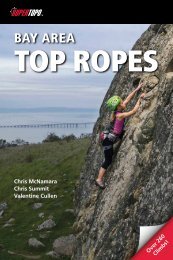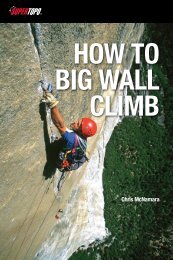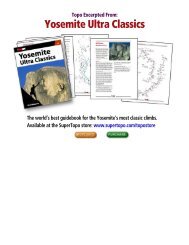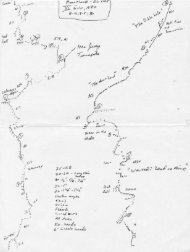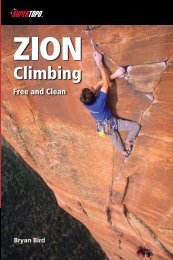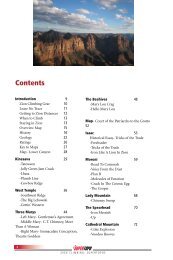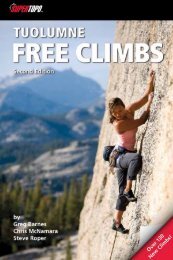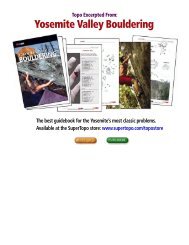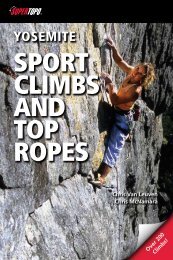The Definitive Guide To Yosemite Big Wall Climbing - SuperTopo
The Definitive Guide To Yosemite Big Wall Climbing - SuperTopo
The Definitive Guide To Yosemite Big Wall Climbing - SuperTopo
You also want an ePaper? Increase the reach of your titles
YUMPU automatically turns print PDFs into web optimized ePapers that Google loves.
Low Impact <strong>Climbing</strong> in Vertical Wilderness<br />
By Jesse McGahey<br />
<strong>Climbing</strong> Ranger, <strong>Yosemite</strong> National Park<br />
Sometimes called the “Granite Crucible”<br />
by climbers, <strong>Yosemite</strong> has always been a place<br />
where concentrated forces interact to influence<br />
advances and developments, not just the<br />
techniques and equipment we use, but also the<br />
code of ethics we follow. John Muir, the father<br />
of the American preservation movement and<br />
a <strong>Yosemite</strong> climber, bagged the first ascent of<br />
Cathedral Peak in 1869. In 1958 the father<br />
of big-wall-wine-drinking and siege tactics,<br />
Warren Harding, first climbed El Cap via <strong>The</strong><br />
Nose route using thousands of feet of fixed<br />
ropes, 45 days of climbing, and 125 bolts.<br />
Starting with the 2nd ascent of <strong>The</strong> Nose, Royal<br />
Robbins, Yvon Chouinard, <strong>To</strong>m Frost, and<br />
others led the change from siege to “alpine”<br />
tactics–fewer bolts, fewer fixed ropes, and fewer<br />
pitons when “clean” protection is available.<br />
Designated as Federal Wilderness by Congress<br />
in 1984, <strong>Yosemite</strong> big walls have a higher<br />
level of legal protection than the Valley floor.<br />
<strong>The</strong> Wilderness Act mandates the National<br />
Park Service (NPS) to protect wilderness<br />
character–distinguished by pristine undeveloped<br />
nature, self-reliance, unrestricted freedom<br />
and adventure, no permanent structures or<br />
installations, and an absence of conveniences.<br />
David Brower and other climbers helped shape<br />
this legislation. Brower, a prominent <strong>Yosemite</strong><br />
mountaineer in the 30s and 40s, was the director<br />
of the Sierra club in the 50s and 60s and his<br />
leadership helped to win the passage of the Act<br />
in 1964. <strong>The</strong> <strong>Yosemite</strong> climber should embrace<br />
the ideals of wilderness, and the development<br />
of big wall ethics over the last half-century<br />
show that, by and large, we have done so.<br />
Most climbers in <strong>Yosemite</strong> now minimize the<br />
placement of bolts and fixed ropes, they avoid<br />
using a hammer or altering the rock, they pack<br />
out their human waste and garbage, and they<br />
volunteer to help keep <strong>Yosemite</strong>’s wilderness<br />
clean and unaltered–preserving a high quality<br />
experience for their fellow climbers today as well<br />
as climbers in the future.<br />
18<br />
YOSEMITE BIG WALLS SUPERTOPOS<br />
However, some climbers are still unaware of<br />
wilderness ethics, and a few others just seem not<br />
to care. <strong>The</strong> actions of this minority, intentional<br />
or not, tarnish the image of the entire climbing<br />
community and negate our efforts to maintain<br />
the wilderness character. In 2010 alone,<br />
climbing rangers removed thousands of feet<br />
of fixed rope and several abandoned poop<br />
tubes from the walls, and–just from Camp<br />
VI on <strong>The</strong> Nose–enough trash and human<br />
waste to fill three large haulbags (and there is<br />
still much more). <strong>The</strong>y also removed dozens<br />
of new fire rings constructed by climbers and<br />
hundreds of pounds of garbage and abandoned<br />
equipment from the base and summit of<br />
the Valley walls. Other park users and NPS<br />
managers are sensitive to abuse of the park,<br />
and unquestionably the best way to continue<br />
maintaining climber freedoms and limiting<br />
regulations is for us to join them as caretakers<br />
of <strong>Yosemite</strong>. <strong>The</strong> following guidelines should be<br />
part of our ethics as climbers, but they are also<br />
backed up by National Park Service regulations.<br />
Wilderness Permits and Camping<br />
Although <strong>Yosemite</strong>’s walls are within<br />
Wilderness, Wilderness Permits are not<br />
required for overnight routes as of 2010.<br />
However, camping anywhere else in designated<br />
Wilderness requires a Wilderness Permit, and<br />
all applicable Leave No Trace (LNT) principles<br />
and rules must be followed: store food in bear<br />
canisters, camp and wash at least 100 feet from<br />
trails and water sources, build campfires only<br />
in established fire rings, bury human waste 6-8<br />
inches underground or pack it out, and carry<br />
out all trash. Spending the night on top of El<br />
Capitan after climbing a wall is considered<br />
part of the climb, but please follow the LNT<br />
rules above and only build a fire in emergency<br />
situations. Trees are being stripped of branches<br />
and dead-and-down wood is needed to<br />
regenerate the scarce organic soils.<br />
Camping at the base of any wall in <strong>Yosemite</strong><br />
Valley–including El Capitan–is prohibited. This<br />
rule may seem unfair, but when you consider




